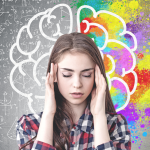Attention Deficit/Hyperactivity Disorder (ADHD) is a diagnosis within the Neurodevelopmental disorders, meaning it highlights differences in the development and functioning of the nervous system. As a neurodevelopmental disorder, we begin to see symptoms in both childhood and adolescence, as children are developing and encountering new situations and responsibilities at school, at home, and with friends. However, this diagnosis can go unreported or undiagnosed long into adulthood. It’s important to identify these symptoms during childhood or adolescence to introduce healthy coping skills and manage them before unhealthy coping skills become cemented behaviors. There are also certain concerns specific to this diagnosis that, when properly addressed, can relieve stressors and pressures on teenagers and children during an already stressful period of life. The purpose of this blog is to understand how the characteristics and symptoms of ADHD will present in our young folks, the challenges specific to these developmental stages, and strategies to support, manage, and empower them.
ADHD is the most common neurodevelopmental disorder impacting 5-7% of all children and teenagers, and symptoms can be prevalent as early as seven years old. There are three classifications of ADHD: Inattentive, Hyperactive/Impulsive, or combined. The easiest way to distinguish between the classifications is to group the characteristics by presenting more as a daydreamer or a fidgeter. A child or teen who displays symptoms of the inattentive type may have trouble staying organized and staying on or completing tasks. They may be constantly daydreaming and not paying attention when spoken to, including following directions. Impulsive and hyperactive are commonly grouped together and may present as spur-of-the-moment decisions with no regard for consequences, focused on the short-term reward, and interrupting when conversing. It may also include behaviors like squirming, fidgeting, tapping, and constant movement, which may feel like ants in their pants, especially in moments that may appear inappropriate. It’s important to identify that these two types of ADHD may present incredibly different. The inattentive type often goes undiagnosed because the behavior isn’t as robust and can be seen as shy or in their own world. While the inattentive type may present with low energy, the hyperactive/impulsive type will be the opposite, with an extremely high level of energy and nowhere to put it. A combined specification would mean that someone could be diagnosed with both classifications and experience symptoms of both.
ADHD, no matter what the classification, significantly impacts teenagers’ ability to perform at school, and this is where identifying the symptoms can be incredibly helpful. Often, the adolescent developmental stage causes teenagers to be expected to handle more responsibility and tasks as they step away from the complete oversight of their caregivers, causing an onset of overwhelming ADHD symptoms. It may look like not completing homework assignments, a drop in grades, lacking interest in study topics, inability to balance school and social life, or challenges keeping up on chores and cleaning their room. The challenge is that these may be present in any adolescent’s experience. Still, if there is a marked change in behavior or consistent effort to change and not being able to, then it may be something worth discussing with services available at the school.
It must be stated that as each individual teenager is a unique representation of themselves, and no one case of ADHD will present the exact same when looking at a closer level, the impact of ADHD will create overt challenges with academics, peer relationships, emotional regulation, and prominent risky behavior.
In terms of Academics, testing, including PSAT and SAT, can be incredibly stress-inducing, not to mention the daily task of homework management. Getting the school involved as early as possible can be important to provide accommodations such as additional time for testing or assignments. It is also vital for there to be communication between parents, teens, and schools so that the parents can be in the loop when major assignments and tests are occurring. Studies show that students with ADHD with parents who stay involved with their assignments have greater success being organized and completing assignments within the given time. A teenager may also benefit from tutors in certain subjects, which may cause extreme challenges or stress.
Another area where an adolescent may feel challenged by symptoms of ADHD is in their peer relationships. Roughly half of teenagers with ADHD have experienced severe problems with their relationships, including bullying and challenges creating friendships. It can be partly due to impulsive behaviors or challenges navigating important social cues. This developmental stage also includes influxes of hormones, which can be exacerbated due to ADHD, further adding the frustration of being able to manage emotions, leading to extreme highs and extreme lows. It can impact an ability to create meaningful relationships as anger and extreme sadness can feel very volatile. It can be important to highlight ways to cool down when feeling overwhelmed and ask for space before reacting. It also can be important to allow for acceptance if an overwhelming behavior occurs and to apologize to those impacted.
Teenagers diagnosed with ADHD are more likely to engage in risky behavior and often start smoking marijuana and nicotine, drinking alcohol, and engaging in unsafe sex earlier than teenagers who are not experiencing the same diagnosis. Usually, this is a coping skill used to manage the frustrating emotions that may otherwise feel foreign, uncomfortable, or unmanageable. This coping skill can grow into a reliance on substances into adulthood. When a teenager begins to drive, there are additional safety risks due to impulsivity or inattention, which can lead to traffic tickets and accidents. Communication once again becomes incredibly important between teenagers and their support system, and there is trust and honesty to share what a teen may be up to in their free time. It should be clear that teenagers can reach out to their parents in challenging times for support and not be afraid of backlash.
If there is a concern that ADHD may be at play, it’s important to reach out to a licensed psychiatrist or mental health professional for formal evaluation. Often, the school will have resources to be able to facilitate this process. Medication can play a huge part in alleviating ADHD symptoms, including stimulant or non-stimulant drugs. Given the relevant circumstances, it’s best to discuss the best option with the psychiatrist. It’s important to include education on how to safely take the medication, as stimulant-based medications are controlled substances and can be habit-forming. Most successful treatment plans pair medication management with behavioral therapies such as Cognitive Behavioral Therapy (CBT) or Dialectical Behavioral Therapy (DBT). Behavioral therapies can do a great job of highlighting the thoughts and feelings that trigger certain behavioral responses that may not serve the individual best. Once this process is understood and the connection between thought, emotion, and behavior is identified, the teen can then begin to intervene with an alternative thought process or managed feeling to shift the behavioral outcome.
There is often a stigma associated with any mental health diagnosis, but it becomes even more apparent when dealing with children and adolescents. This fact is the most common reason which leads parents not to pursue a diagnosis for their child. However, understanding that a diagnosis can also offer relief from the struggles that an adolescent or child with ADHD may be experiencing. Introducing open and kind communication on the importance of mental health and normalizing this process between parent and child is incredibly beneficial. Setting an example for accepting and managing these symptoms can increase self-esteem and mastery of skills, which can set the stage for positive development into adulthood.



